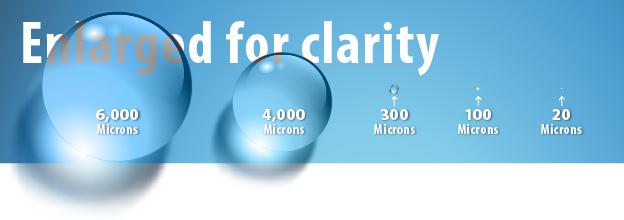Droplet Size and Spray Angle

Droplet Size
| Model | Liquid Pressure | Air Pressure | Droplet Size (µm) |
|---|---|---|---|
| AN1020SS | 20 PSI | 40 PSI | 71 |
| AN1020SS | 40 PSI | 65 PSI | 83 |
| ER1020SS | 5 PSI | 40 PSI | 39 |
| ER1020SS | 20 PSI | 40 PSI | 57 |
| SR1020SS | 4" Siphon Height | 20 PSI | 25 |
| SR1020SS | 4" Siphon Height | 40 PSI | 22 |
* Volume Median Diameter DV(50.0) of liquid droplets.
1 µm = 1 micron = 0.00004". All tests performed with water.
One of the primary reasons atomizing spray nozzles are used is because of their fine droplet size. Benefits of fine droplet size include even coating and liquid conservation. For reference, a large raindrop is around 6,000 microns (0.236") in diameter. Standard liquid nozzles produce droplet sizes ranging from 4,000 microns (0.157") down to 300 microns (0.012") in diameter. EXAIR's Atomizing Nozzles produce minuscule droplet sizes in the range of 100 microns (0.004") to 20 microns (0.0008")!
Droplet size can be adjusted by varying either the air or liquid pressure. An increase in air pressure or decrease in liquid pressure will generally produce a smaller droplet size. Below is a chart showing various models of atomizing air nozzles and their droplet sizes at selected pressures.
Spray Angle
| Family | Minimum Angle | Maximum Angle |
|---|---|---|
| Internal Mix Narrow Angle Round Pattern - AN1010SS, AN2010SS, etc. |
20° | 45° |
| Internal Mix Wide Angle Round Pattern - AW1010SS, AW2010SS, etc. |
50° | 90° |
| Internal Mix Flat Fan Pattern - AF1010SS, AF2010SS, etc. |
50° | 120° |
| External Mix Round Pattern - ER1010SS, ER2010SS, etc. |
25° | 60° |
| External Mix Narrow Angle Flat Fan Pattern - EF1010SS, EF2010SS, etc. |
35° | 70° |
| External Mix Wide Angle Flat Fan Pattern - EB1010SS, EB2010SS, etc. |
50° | 105° |
| Siphon Fed Round Pattern - SR1010SS, SR2010SS, etc. |
20° | 55° |
| Siphon Fed Flat Fan Pattern - SF1010SS, SF2010SS, etc. |
50° | 100° |
The Spray Angle is the trigonometric angle created by the width of the spray pattern and the distance at which it is measured. This angle can vary greatly within a given family of atomizing nozzles depending on flow rates and pressures, but will generally fall into the ranges below:


